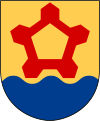Mörbylånga (municipality)
| Mörbylånga municipality | |||||
|---|---|---|---|---|---|
|
|||||
| State : | Sweden | ||||
| Province (län): | Kalmar Lan | ||||
| Historical Province (landskap): | Öland | ||||
| Main place: | Mörbylånga | ||||
| SCB code: | 0840 | ||||
| Residents : | 15,249 (December 31, 2019) | ||||
| Area : | 668.5 km² (January 1, 2016) | ||||
| Population density : | 22.8 inhabitants / km² | ||||
| Website : | www.morbylanga.se | ||||
| List of municipalities in Sweden | |||||
Coordinates: 56 ° 32 ′ N , 16 ° 23 ′ O Mörbylånga is a municipality ( Swedish commun ) in the Swedish province of Kalmar Lan and the historic province of Öland . The main town of the municipality is Mörbylånga .
geography
The municipality makes up the southern part of the Baltic island of Öland. A large part of the area is covered by the barren Alvar landscape of the Stora Alvaret , which, along with the surrounding areas and unusual flora and fauna, is part of the world cultural heritage of the agricultural landscape of southern Öland . There are various wetlands in Stora Alvaret and the surrounding area. The largest is the Alvarsee Möckelmossen . Other wetlands are Bårbykärret , Dröstorpmossen , Frösslundamossen , Kvarnkärret , Södra utmossen , Stormaren , Triberga-Alby-mosse and Vanserums mossar . While there are no larger rivers, there are some smaller streams such as the Frösslundabäcken and the Penåsabäcken .
In the municipality there is only a larger forest area in the northern part with the Mittlandsskogen . Small forests are the Ottenbylund on the southern tip and the western Albrunna lund . With Beijershamn and the Ottenby nature reserve there are also important bird sanctuaries in the municipality.
Länsväg 136 runs along the west coast to Kalmarsund . North of Färjestaden , Ölandsbron is the only fixed connection between Öland and the mainland.
history
The municipality was created in 1952 by merging the market town of Mörbylånga with the municipality of Mörbylånga and some parishes ( socken ) in the surrounding area. In 1967 the municipality of Mörbylånga was expanded to include the municipality of Ottenby and in 1974 the municipality of Torslunda .
The fact that Öland's settlement history reaches far into prehistoric times can be seen from the many legacies from this time. With the castle of Bårby , Gråborg Träby borg and Triberga borg the remains of old castles and refuges are on the territory of the municipality. The most famous, however, is the reconstructed Eketorp Castle . In addition to old rune stones such as the Björnflisan , Karlevistein , Kungsstenarna , Stein von Klinta and the Tingstad flisor , southern Öland is also known for large burial grounds such as that of Gettlinge or Seby and the Röse of Gösslunda .
More recent are places that have become desolate, such as Dröstorp or the Österskog , which is still in existence today , whose history testifies to the harsh living conditions of the people on Öland in the past.
places
The following places are localities ( tatorter ) :
There are also several Småorte such as Albrunna and Hulterstad , as well as various villages with fewer than 50 inhabitants such as Frösslunda , Gösslunda , Mysinge , Österskog , Ottenby , Sandby and Triberga .
Buildings
The Långe Jan lighthouse is one of the most famous buildings in Öland on the southern tip of the island. A little to the north of this is Karl X Gustafs mur , a wall that separated the southernmost part of the island from the rest of the island. The former saddle church Resmo, which dates back to the Middle Ages, is remarkable . In Algutsrum in the north of the municipality, right next to the church, is the Algutsrum market , whose wooden stalls date from the 18th century.
North of Färjestaden near the Öland Bridge, the island's only leisure park, Ölands Djur & Nöjespark, was created .
Web links
- Official website (Swedish)
Individual evidence
- ↑ Folkmängd i riket, län och kommuner December 31, 2019 at Statistiska centralbyrån
- ↑ Kommunarealer January 1, 2016 at Statistiska centralbyrån (including all inland waters)




